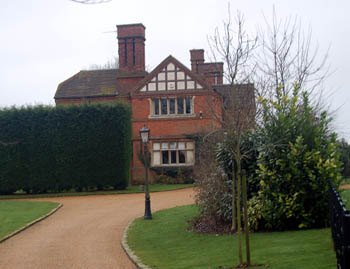Fountaines Farm Milton Bryan

Fountaine's Farm January 2008
Fountaine’s Farmhouse was listed by English Heritage in May 2000 as Grade II, of special interest. It was built in 1875 (see below) and has 20th century alterations. The house is made of red brick with details picked out in ashlar and decorative brick; the roof is composed of clay tiles.
In 1793 the site of the present Fountaine’s Farm was occupied by a farm house and a barn in the ownership of James Sibthorpe [MA70/2]. In 1836 it passed to Newland Fountaine and Thomas Sibthorp Fountaine, hence the farm’s name. Members of the Fountaine family sold to the Duke of Bedford in March 1872.
In 1875 it was decided by the estate to run the two adjacent farms as one and the estimates for 1876-1876 include £1,400 for a new farm house and £300 for a new yard and farm buildings. The combined acreage of the farm was 227 acres at a rental of £372 per annum, of which 130 acres, 3 roods, 14 perches (£237/10/- rental) had been purchased from a man named Cook and 96 acres 36 perches (£135 rental) from the Fountaines.
The architect was the Duke of Bedford’s favourite – William Clutton, who also designed the new church in Woburn and at Aspley Heath. His bill is to be found in the Russell Estate vouchers for 1875-1876 in a bundle named “Works and Buildings”. The bill broke down as follows:
- For preparing a set of working drawings and specifications for the new farm house: £50;
- For providing duplicates of the above with builders’ estimates: £25;
- For superintending the works 2½% on £1,100 expended up to the present time: £27/10/-;
- For journeys, travelling and incidental expenses: £20/12/-;
This made a total of £123/2/-. He was paid in full on 22nd January 1876.
Number 16 in the same bundle is the bill due to William Wright, the Clerk of Works: for superintending the works from 28th February to 22nd April 1876: £11/12/-. He was paid on 3rd May 1876. The actual builder was John Hull. From the Journal of Labourers it appears that the old buildings were finally demolished by 15th December 1876, in other words after the completion of the new house.
The Rating and Valuation Act 1925 specified that every building and piece of land in the country was to be assessed to determine its rateable value. The valuer visiting the farm (on 10th August 1926) found it still owned by the Duke of Bedford’s London and Devon Estates Company and occupied by Harry Ernest Pickering whose rent was £225/10/- per annum, up from £175 before the Great War and fixed in 1920 when the farm increased in size. The farm comprised the farm buildings and 227 acres (it had been 215 acres, 1 rood, 6 poles pre-war). The valuer commented: “Saw Mr. Pickering said game troublesome. Nearest market Leighton. Nearest station 5½ miles. Water supply fairly good generally”.
![Fountaine's Farm on the 1925 rating valuation map [DV2-C26]](/CommunityHistories/MiltonBryan/MiltonBryanImages/Fountaines Farm on the 1925 rating valuation map [.jpg)
Fountaine's Farm on the 1925 rating valuation map [DV2/C26]
The farmhouse comprised two reception rooms, a kitchen, a scullery, a cellar and a dairy with five bedrooms upstairs. Outside stood an earth closet and a wood shed. The homestead was divided into five groups as shown on the map above. They comprised as follows:
- West Block (A): a wood and slate stable for two horses; a four bay open shed and loosebox tie ups for three animals;
- North Block (B): a wood and slate cow house for eight beasts; two calf pens; a calf box; a food store; a cow house for three; a large barn with a brick floor; a three bay open cart shed and a tool shed;
- East Block (C): a small chaff house; a stable for five; a granary with four bins and a hen house;
- Centre Block (D): a wood and slate three bay open shed with temporary boarding in front and a four bay open shed;
- Centre Block (E): a cooling house; a cow house for fourteen and three pigsties;
At the rear of the house was a brick and slate trap house. There was also a two stall stable, a work shop and a coal house.
Directories for Bedfordshire were not published every year but every few years from the early to mid 19th century until 1940. The following mentions of Fountaine’s Farm occur in directories
- 1877 William Holmes;
- 1885, 1890, 1894, 1898, 1903 and 1906 Harry George Pickering;
- 1910, 1914, 1920, 1924 and 1928 Harry Ernest Pickering;
- 1931, 1926 and 1940 Albert Heady